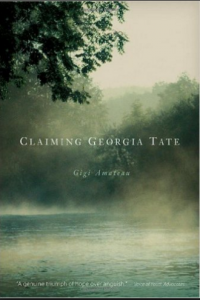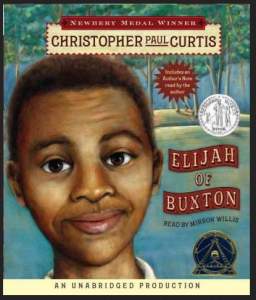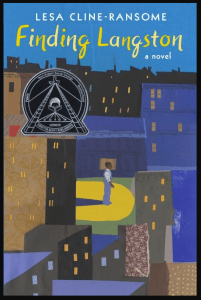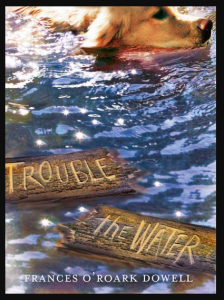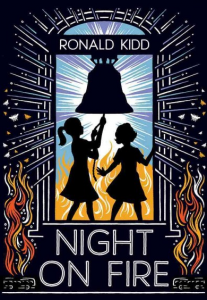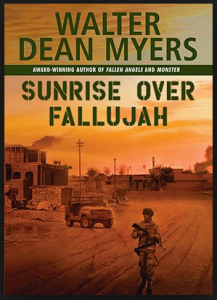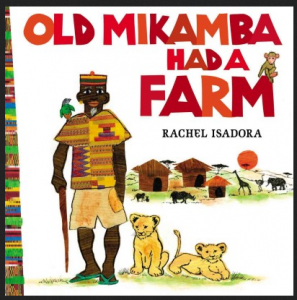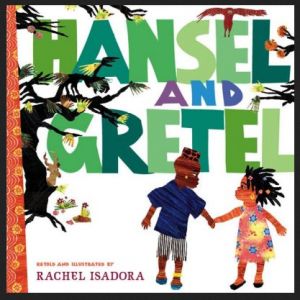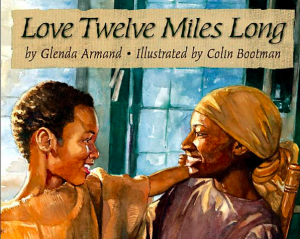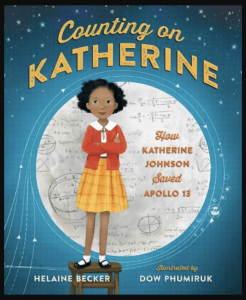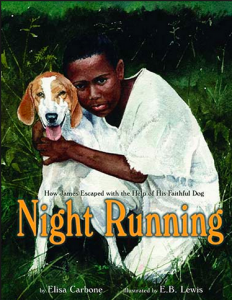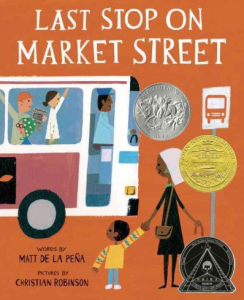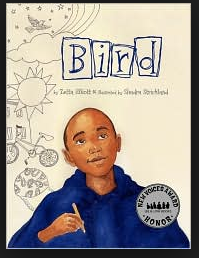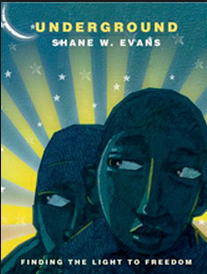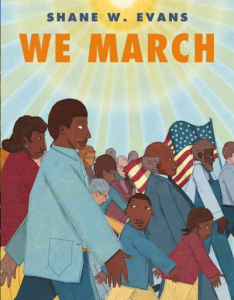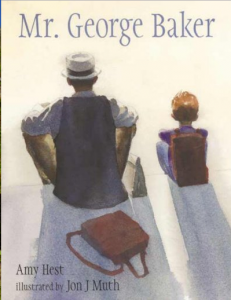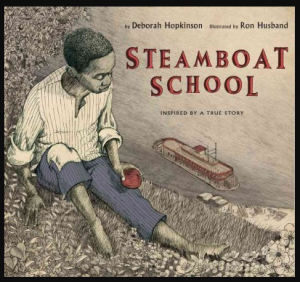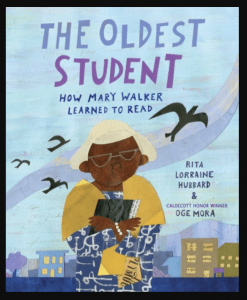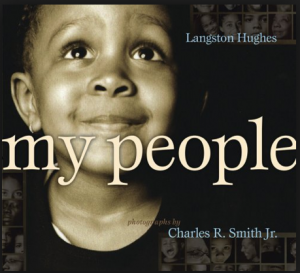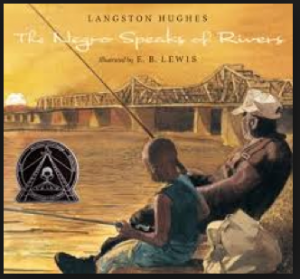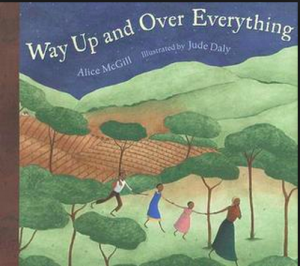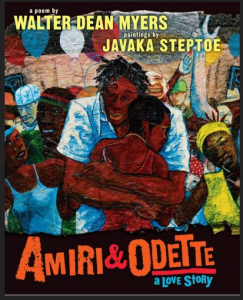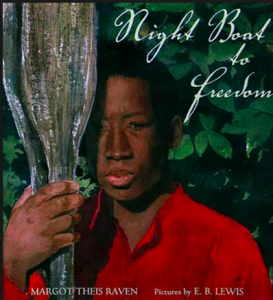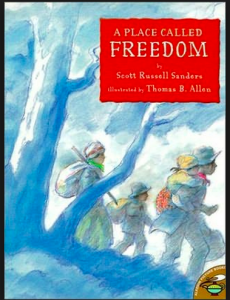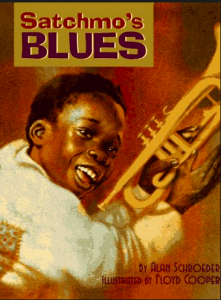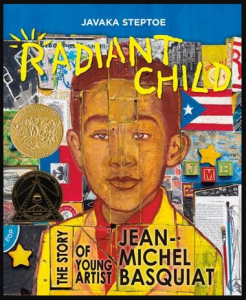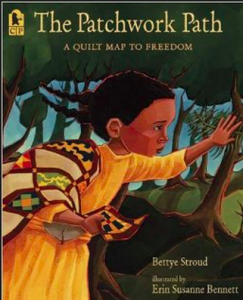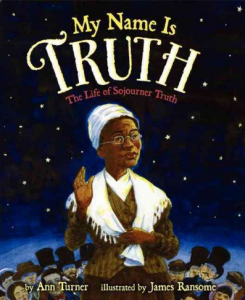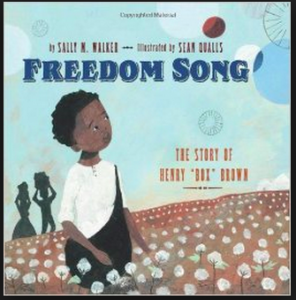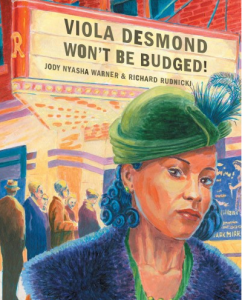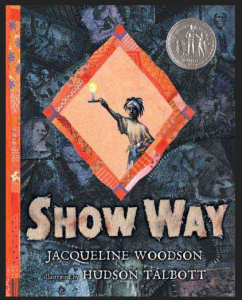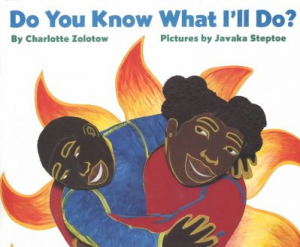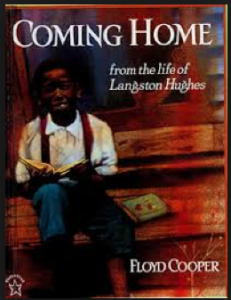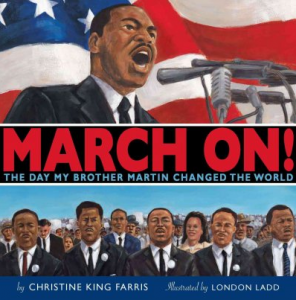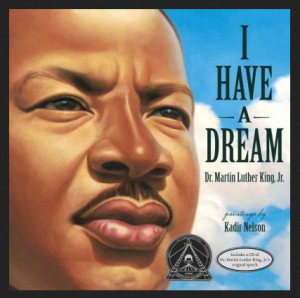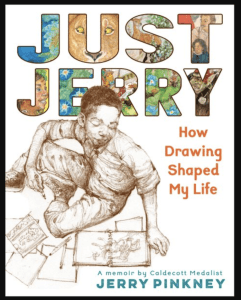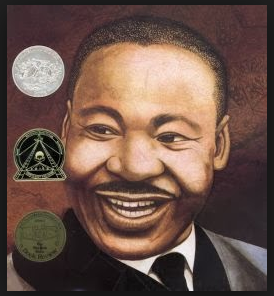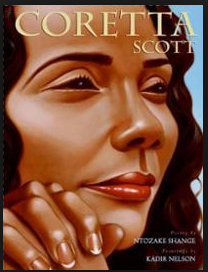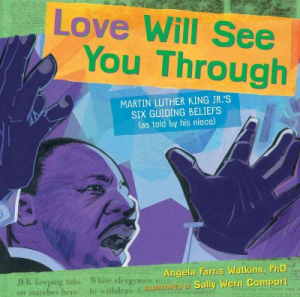“I am where I am because of the bridges that I crossed. Sojourner Truth was a bridge. Harriet Tubman was a bridge. Ida B. Wells was a bridge. Madame C. J. Walker was a bridge. Fannie Lou Hamer was a bridge.” – Oprah Winfrey
NOVELS
Amateau Gigi. Claiming Georgia Tate. Cambridge, Mass.: Candlewick Press, 2005.
“Twelve-year-old Georgia Tate feels loved and safe living with Nana and Granddaddy, until her sexually abusive father tries to win her custody.” – FVRL. Sent to live with her father in Florida, Georgia escapes with the help of a transsexual living in a neighbouring apartment. On the long bus journey back home to Mississippi, she meets an African-American on his way home after being falsely imprisoned. This 196-page novel told from the first-person point of view is recommended for readers 13-years-old and up. Shorter and easier to read than The Lions of Little Rock by Kristin Levine, it is similar in its depiction of a character who learns to stand up for what is right. [Abuse; Courage; Custody of children; Fathers and daughters; Grandparents; Incest; Mississippi; Racism]
Armstrong, William H. Sounder.
Cline-Ransome, Lesa. Finding Langston. New York: Holiday House, 2018.
After the death of his mother in 1946, eleven-year-old Langston moves with his father from Alabama to Chicago. Living in a lonely apartment building and bullied at school, Langston finds refuge in the school library where he discovers the magical poetry of Langston Hughes.Have you ever felt alone? Have you ever felt misunderstood by those who love you? Have you ever found hope in unexpected places? Then you know how the main character feels in this outstanding novel for readers 9 years old and up. Told in present tense from the first person point of view, the sentences come alive with the cadence of the main character’s Southern speech. If you like stories by Patricia MacLachlan, you will love this 104-page novel. [African Americans; Books and reading; Bullying; Chicago, (Ill.); Grief; Historical fiction; Moving, Household; Poetry]
Codell, Esme Raji. Sahara Special.
Codell, Esme Raji. Viva la Paris.
Curtis, Christopher Paul. Bud, Not Buddy.
Curtis, Christopher Paul. Elijah of Buxton.
Curtis, Christopher Paul. The Watsons Go to Birmingham – 1963.
Dowell, Frances O’Roark. Trouble the Water. New York: Atheneum Books for Young Readers, 2016.
An old yellow dog brings Cassie and Wendell – a black girl and a white boy – together in racially segregated Kentucky in 1953. Buddy leads them to a ramshackle cabin in the woods where two invisible boys are waiting to cross the nearby river. Partly historical fiction, partly a ghost story, this memorable novel by a thought-provoking writer is highly recommended for readers 10 to 15 years old.
P.S. Do you know the story of how Jesus healed the sick man by the pool of Bethesda? The man who never got to the pool in time to be healed after an angel ‘troubled the water’? You might like to read about it in John 5 after you read Dowell’s story. Then you might like to think about the Pharisees in the Bible and the townspeople in the story. And think about that pool at the end of the novel. Might you be called to be an angel?
Draper, Sharon M. Double Dutch.
Fenner, Carol. Yolanda’s Secret.
Flake, Sharon G. The Skin I’m In.
Greene, Bette. Get On Out of Here, Philip Hall.
Greene, Bette. Philip Hall Likes Me, I Reckon Maybe.
Holt, Kimberly Willis. Mister and Me.
Hamilton, Virginia. M.C. Higgins, the Great.
Hamilton, Virginia. The Planet of Junior Brown.
Hamilton, Virgina. Sweet Whispers, Brother Rush.
Hamilton, Virginia. Zeely.
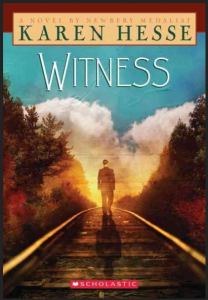
Hesse, Karen. Witness.
Holt, Kimberly Willis. Mister and Me.
Johnson, Angela. Heaven.
Kidd, Ronald. Night on Fire. Chicago: Albert Whitman & Company, 2015.
Hoping that the arrival of Freedom Riders in her town will help her community shed its antiquated views, thirteen-year-old Billie is forced to confront her own mindset when things turn tragic.” – CIP. [Alabama; Civil rights movements; Courage; Freedom Rides, 1961; Friendship; Racism; Violence]
Kidd, Sue Monk. The Secret Life of Bees.
Konigsburg, E.L. Jennifer, Hecate, Macbeth, William McKinley, and Me, Elizabeth.
LaFaye, A. The Strength of Saints.
Lasky, Kathryn. True North.
Lee, Harper. To Kill a Mockingbird.
Levine, Gail Carson. Dave at Night.

Levine, Kristin. The Lions of Little Rock.
Twelve-year-old Marlee is shy. She likes thinking and she likes math, but she doesn’t like talking so much. And she is not courageous. But when high schools are closed in her home town because local officials oppose integration, Marlee learns to speak up. Well-researched and based on true events from 1959, this novel will appeal to readers twelve years old and up. [Arkansas; African Americans; Racism; Schools; Family life; Mothers and daughters; Historical fiction; Friendship; Courage; Mathematics; Faith]
Lord, Bette Bao. In the Year of the Boar and Jackie Robinson.
Lunn, Janet. The Root Cellar.
Mathis, Sharon Bell. Sidewalk Story.
McMullan, Margaret. Sources of Light.
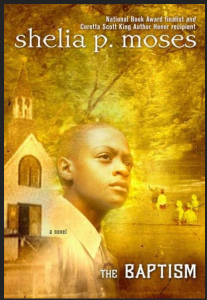
Moses, Sheila P. The Baptism.
…
Myers, Walter Dean. Fallen Angels.
Myers, Walter Dean. Lockdown.
Myers, Walter Dean. Scorpions.
Myers, Walter Dean. Sunrise over Fallujah.
Napoli, Donna Jo. North.
Rhodes, Jewell Parker. Sugar. New York : Little, Brown, 2013.
“In 1870, Reconstruction brings big changes to the Louisiana sugar plantation where spunky ten-year-old Sugar has always lived, including her friendship with Billy, the son of her former master, and the arrival of workmen from China.” – CIP [African Americans; Chinese Americans; Courage; Friendship; Historical fiction; Individuality; Louisiana; Orphans; Race relations; Racism]

Scattergood, Augusta. Glory Be. New York: Scholastic, 2012.
“In the summer of 1964 as she is about to turn twelve, Glory’s town of Hanging Moss, Mississippi, is beset by racial tension when town leaders close her beloved public pool rather than desegregating it.” FVRL [Courage; Friendship; Historical fiction; Mississippi; Racism; Segregation; Sisters; Summer]
Staples, Suzanne Fisher. Dangerous Skies.
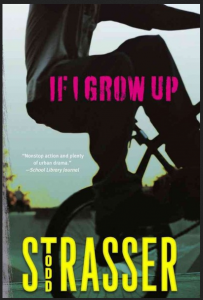
Strasser, Todd. If I Grow Up. New York: Simon & Schuster Books for Young Readers, 2009.
“Growing up in the inner-city projects, DeShawn is reluctantly forced into the gang world by circumstances beyond his control.” – CIP. [African Americans; Gangs; Inner cities; Poverty; Violence]
Taylor, Mildred D. The Gold Cadillac.
Taylor, Mildred D. The Land.
Taylor, Mildred D. Let the Circle be Unbroken.
Taylor, Mildred D. Roll of Thunder, Hear My Cry.
Taylor, Mildred D. Song of the Trees.
Taylor, Mildred D. The Well.
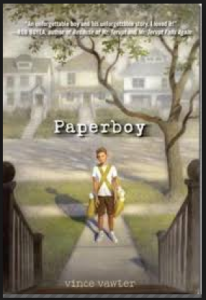
Vawter, Vince. Paperboy. New York: Delacorte, 2013.
“When an eleven-year-old boy takes over a friend’s newspaper route in July 1959, in Memphis, his debilitating stutter makes for a memorable month.” – CIP. A Newbery Honor Book, highly recommended for readers 10 to 15 years old. [Bullying; Family life; Newspaper carriers; Race relations; Stuttering; Tennessee]
Voigt, Cynthia. Come a Stranger.
Walters, Eric. Black and White.
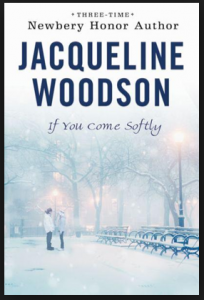
Woodson, Jacqueline. Behind You.
Woodson, Jacqueline. Feathers.
Woodson, Jacqueline. Hush.
Woodson, Jacqueline. If You Come Softly.
Woodson, Jacqueline. Locomotion.
Woodson, Jacqueline. Peace, Locomotion.
…
FOLKTALES
Aardema, Verna. Who’s in Rabbit’s House.
Aardema, Verna. Why Mosquitoes Buzz in People’s Ears.
Grifalconi, Ann. The Village of Round and Square Houses.
Isadora, Rachel. Hansel and Gretel.
Isadora, Rachel. The Princess and the Pea.
Isadora, Rachel. Rapunzel.
Isadora, Rachel. The Twelve Dancing Princesses.
McDermott, Gerald. Anansi the Spider.
Steptoe, John. Mufaro’s Beautiful Daughters.
PICTURE BOOKS
“Darkness cannot drive out darkness; only light can do that. Hate cannot drive out hate; only love can do that.” – Martin Luther King, Jr.
Angelou, Maya. Life Doesn’t Frighten Me.
Armand, Glenda. Love Twelve Miles Long. New York: Lee & Low Books, 2011.
“In 1820s Maryland, Frederick’s mother, who is a slave on a different plantation, walks twelve miles each way for a nighttime visit with her son, during which she recounts what each mile of the journey represents. Based on the childhood of Frederick Douglass.” – CIP.
Becker, Helaine. Counting on Katherine: How Katherine Johnson Saved Apollo 13. New York: Henry Holt and Company, 2018.
Katherine was a child who loved numbers. But in the 1920s and ’30s, girls did not grow up to become mathematicians. So Katherine became a school teacher. Until in the 1950s, she finally got a chance to work for America’s National Advisory Committee on Aeronautics. For 35 years, her calculations of flight-paths helped to safely send astronauts around the world, to the moon, and back again to Earth. She died on February 24, 2020 at 101 years of age. This picture book illustrated by Dow Phumiruk is highly recommended for curious readers 9 years old and up.
…
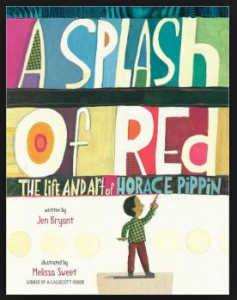
Bryant, Jen. A Splash of Red: the Life and Art of Horace Pippin.
Carbone, Elisa. Night Running: How James Escaped with the Help of His Faithful Dog: Based on a True Story. New York: Alfred A. Knopf, 2008.
“A runaway slave makes a daring escape to freedom with the help of his faithful hunting dog, Zeus. Based on the true story of James Smith’s journey from Virginia to Ohio in the mid-1800s.” – CIP.
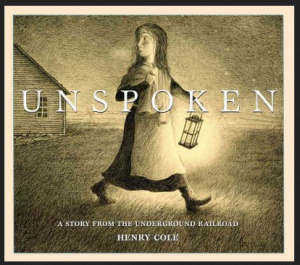
Cole, Henry. Unspoken: Story from the Underground Railroad. New York: Scholastic Press, 2012.
“In this wordless picture book, a young Southern farm girl discovers a runaway slave hiding behind the corn crib in the barn and decides to help him.” – FVRL.
de la Peña, Matt. Last Stop on Market Street. New York: G.P. Putnam’s Sons, 2015.
“A young boy rides the bus across town with his grandmother and learns to appreciate the beauty in everyday things.” – CIP. “Sometimes when you’re surrounded by dirt…you’re a better witness for what’s beautiful.” [Buses; City and town life; Grandmothers]
Crews, Nina. Extraordinary Magic. New York: Little, Brown and Company, 2024.
What words would you choose to tell the story of your life?
How could you turn those words into poems about your life?
Nina Crews, author of over a dozen children’s books, uses poems and pictures to tell the story of Virginia Hamilton, author of over forty books and winner of multiple awards including the Newbery Medal in 1975. Most young readers today – at least in Canada – will not be familiar with Hamilton’s folktales and realistic novels about life for African Americans. This picture book is an excellent introduction to an author who excelled at writing complex stories that did not flinch from life’s ugliness while still celebrating its beauty. Recommended for readers up to 15 years of age.
Elliott, Zetta. Bird. New York: Lee & Low Books, 2008.
A young African American boy draws the world around him while trying to understand his older brother’s drug addiction. This gentle picture book will be appreciated by children and adults. Teachers might like to use it for lessons on reading between the lines as readers will easily see that they understand far more than the main character. The book is also useful for discussions on writing in free verse and ways of dealing with drug abuse. [Brothers; Family life; Drug abuse; Drawing; Novels in verse; Death; Style, Literary – Study and teaching].
Evans, Shane W. Underground. New York: Roaring Brook Press, 2011.
“A pivotal moment in American history is shared with young readers by following a slave family’s escape to the North by crawling on the ground, running barefoot through the woods, sleeping beneath bushes and eventually reaching freedom.” – Baker & Taylor. Highly recommended as a read-aloud: read the very brief story aloud without showing the book; discuss inferences and connections; read the story again so that listeners can see the illustrations; discuss the power of pictures to tell a story. [Abolitionists; Runaways; Slavery; Underground Railroad]
Evans, Shane W. We March. New York : Roaring Brook Press, 2012.
Short sentences accompany the full-page illustrations telling the story of Martin Luther King Jr.’s famous speech in 1963. Highly recommended as a read-aloud introduction to this famous historical event.
Hesse, Karen. Come On, Rain. New York: Scholastic, 1999.
Click HERE to listen and watch the story on YouTube.
Hest, Amy. Mr. George Baker. Cambridge, MA.: Candlewick Press, 2004.
“Harry sits on the porch with Mr. George Baker, an African American who is one hundred years old but can still dance and play the drums, waiting for the school bus that will take them both to the class where they are learning to read.” – CIP. An elegant font and illustrations by Jon J. Muth combine to tell this touching story for readers of all ages.
Hopkinson, Deborah. Steamboat School: Inspired by a True Story. Los Angeles: Disney•Hyperion, 2016.
A law against educating African Americans was established in Missouri in 1847. But a minister – John Meachum – found a way around this restriction by creating a school in the middle of the Mississippi River. Ron Hubbard, the first African American animator at Disney Studios, provides vivid illustrations for this moving story useful as a read-aloud for readers 9 years old and up. An afterward provides additional information including recommended websites and books. [Historical fiction; Missouri; Racism; Schools]
Hubbard, Rita Lorraine. The Oldest Student: How Mary Walker Learned to Read. New York: Schwartz & Wade Books, 2020.
Once in a while, a book soars above all the rest. The illustrations convey emotions as well as plot details. The size and style of the font matches the tone of the story and the age of the intended readers. The words sing with the rhythm of a story told over and over aloud, and the design turns it all into a work of brilliance.
This picture book is brilliant right from the beginning. It tells the story of Mary Walker, born a slave in 1848 and growing up to labour in the cotton fields, toil in the Big House, and follow the rules: work, work, work. Do not learn to read. When Mary was fifteen years old, freedom came, but she was desperately poor and still had to work. Mary Walker married, gave birth to a son, was widowed, married again and gave birth to two more sons. Year after year, she kept working and working – and dreaming of being able to decipher the squiggles she saw on billboards and signs. Finally, when she was 114 years old, she decided it was time she learned how to read. And she did!
This inspiring picture book – illustrated by Oge Mora – is most highly recommended for all readers 8 years old and up.
Hughes, Langston. My People. New York: Atheneum Books for Young Readers, 2009.
Hughes, Langston. The Negro Speaks of Rivers. New York: Jump at the Sun, 2009.
Keats, Ezra Jack. Peter’s Chair.
Keats, Ezra Jack. Apt. 3.
Keats, Ezra Jack. The Snowy Day.
McDaniel, Breanna J. Go Forth and Tell. New York: Dial Books for Young Readers, 2024.
This gorgeous picture book – illustrated by April Harrison – tells the story of Augusta Baker, a little girl who loved listening to her grandmother’s stories and who grew up to become a teacher who loved telling her own stories, as well as the first African American librarian to be head of children’s services in the New York Public Library system. Highly recommended for readers of any age who like telling stories and creating works of art.
McGill, Alice. Way Up and Over Everything. Boston: Houghton Mifflin, 2008.
“In this retelling of a folktale, five Africans escape the horrors of slavery by simply disappearing into thin air.” – CIP. Recommended for readers 10-years-old and up.
Miller, William. Richard Wright and the Library Card.
Myers, Walter Dean. Amiri and Odette: A Love Story: A Poem.
Myers, Walter Dean. Blues Journey.
Myers, Walter Dean. Looking Like Me.
Pinkney Andrea Davis. Sit-In: How Four Friends Stood Up by Sitting Down. New York: Little, Brown Books for Young Readers, 2010.
Raven, Margot Theis. Night Boat to Freedom. New York: Farrar, Straus and Giroux, 2006. New York : Farrar, Straus and Giroux, 2006.
“At the request of his fellow slave Granny Judith, Christmas John risks his life to take runaways across a river from Kentucky to Ohio. Based on slave narratives recorded in the 1930s.” – CIP. [Fugitive slaves; Slavery; Underground Railroad]
Sanders, Scott Russell. A Place Called Freedom. New York: Atheneum Books for Young Readers, 1997.
“After being set free from slavery in 1832, young James Starman and his family journey from Tennessee to Indiana to start a new life and over the years they are joined by so many blacks that they start their own town.” – CIP.
Schroeder, Alan. Satchmo’s Blues.
Steptoe, Javaka. Radiant Child: the Story of Young Artist Jean-Michel Basquiat. New York: Little, Brown and Company, 2016.
Brilliant double-page illustrations help tell the true story of a collage-style New York artist who died of a drug overdose in 1988 at the age of only 27. The colour, energy, and detail in Steptoe’s paintings are astonishing. An afterward tells more about both Basquiat and Steptoe and could be used to start all sorts of discussions on the effect of childhood experiences and the nature of creativity. This sophisticated picture book – winner of the Caldecott Medal – is highly recommended for artists of all ages. [Artists; Biographies; Caldecott Medal; Creativity; New York (City)]
Stroud, Bettye. The Patchwork Path: A Quilt Map to Freedom. Cambridge, Mass.: Candlewick Press, 2005.
A young girl recalls the quilt code she learned from her mother as her father leads her away from slavery to safety in Canada. A fascinating story that flows smoothly for reading aloud, with large emotive illustrations by Erin Susanne Bennett to hold the attention of young listeners. This picture book will also appeal to anyone of any age who is interested in history.
Turner, Ann. My Name is Truth: the Life of Sojourner Truth. New York: Harper, 2015.
“A vibrantly illustrated story of how former slave Isabella Baumfree transformed herself into the preacher and orator Sojourner Truth, one of the most inspiring and important figures of the abolitionist and women’s rights movements.” – CIP. Illustrated by the acclaimed James Ransome and accompanied by historical information at the end, this biography – told from the first person point of view – is highly recommended for readers 8-years-old and up.
Walker, Sally M. Freedom Song: The story of Henry ‘Box’ Brown. New York: Harper, 2012.
“Henry Brown copes with slavery by singing, but after his wife and children are sold away he is left with only his freedom song, which gives him strength when friends put him in a box and mail him to a free state.” – CIP [Singing; Slavery; Underground Railroad]
Warner, Jody Nyasha. Viola Desmond Won’t Be Budged! Toronto: Groundwood Books, 2010.
The true story of an African Canadian who refused to give up her seat in a movie theatre and move to the balcony reserved for black patrons. This courageous act in Nova Scotia in 1946 started the move to end racial segregation in Canada. Illustrated by Richard Rudnicki and accompanied by additional historical information at the end, this picture book is recommended for readers 8-years-old and up.
Whelan, Gloria. Friend on Freedom River. Chelsea, MI: Sleeping Bear Press, 2004.
“On a cold December night, Louis must decide whether to brave the treacherous Detroit River to take a slave family to freedom.” – CIP. [Courage; Fugitive slaves; Slavery; Underground Railroad]
Woodson, Jacqueline. Coming on Home Soon.
Woodson, Jacqueline. The Other Side.
Woodson, Jacqueline. Show Way.
In Show Way, Soonie’s great-grandmother was sold when she was 7 to be a slave without being paid because she was a black person. She sewed a quilt that showed maps to freedom, to a place where there was no slavery. Even now, when there’s no slavery, Soonie’s family makes family tree quilts which show the family from generation to generation. The author, Jacqueline Woodson, created a very excellent book that makes readers wonder if Soonie’s great-grandmother is ever going to get to the freedom place without being caught. The book is also excellent because it is filled with historical facts about the civil war and slavery. (Gwilim)
Woodson, Jacqueline. The Year We Learned to Fly. New York: Nancy Paulsen Books, 2022.
What do you do in spring when it’s raining outside and you have to stay inside? What do you do in summer when you have to do chores and can’t stop quarrelling with your brother? What do you in autumn when it’s dark outside and you’re stuck inside? What do you do in winter when you move somewhere new and you don’t know anyone at all? Well, use your imagination, of course! Remember the strong people who came before you. Lift up your arms, close your eyes, and let your mind fly! This joyous and inspiring picture book – illustrated by Rafael López – is highly recommended for readers of all ages.
P.S. Any book published by Nancy Paulsen Books is worth picking up. Sometimes you might not be ready for a particular story, but the quality of the writing will always be superb.
Zolotow, Charlotte. Do You Know What I’ll Do? New York: HarperCollinsPublishers, 2000.
“A little girl delights her brother with a series of promises about all the wonderful things she’ll do to make him happy as they both grow up.” – CIP. The question is repeated over and over in this hopeful story illustrated by Javaka Steptoe. Recommended for readers of all ages.
Nonfiction
“The time is always right to do what is right.” – Martin Luther King, Jr.
Cooper, Floyd. Coming Home: From the Life of Langston Hughes. New York: Philomel, 1994.
Fandel, Jennifer. Martin Luther King, Jr.: Great Civil Rights Leader. Mankato, MN: Capstone Press, 2007.
Farris, Christine King. March On!: The Day My Brother Martin Changed the World. New York: Scholastic Press, 2008.
Martin Luther King Jr.’s sister tells the story of her brother’s famous speech: “I Have A Dream”. Full-page coloured illustrations by London Ladd enhance the dignity and drama of this informative picture book for readers 9 years old and up.
King, Martin Luther, Jr. I Have a Dream. New York : Schwartz & Wade Books, 2012.
Pinkney, Jerry. Just Jerry: How Drawing Shaped My Life. New York: Little, Brown and Co., 2023.
Jerry Pinkney always loved drawing. He would lie on his bunk bed and draw pictures on the wall. He would lie under the piano in the living room of the small house where he lived and draw pictures in his sketchpad. He would ride his bicycle through the streets of Philadelphia and stop to draw more pictures. School was difficult, especially in the 1940s and 50s when few people recognized dyslexia. But when Jerry picked up a pencil and started to draw, he came alive. This memoir is a vivid account of Pinkney’s childhood and young adulthood. Right from the first page, the style of writing pulls a reader into the life of a boy growing up in a city where African Americans didn’t feel safe if they ventured beyond their neighbourhoods. It immerses readers in the life of a large loving family and shows how Pinkney was able to become one of the most famous children’s book illustrators in America. Highly recommended for readers 10 years old and up.
Rappaport, Doreen. Martin’s Big Words: the Life of Martin Luther King, Jr. New York: Jump at the Sun/Hyperion Books for Children, 2001.
Shange, Ntozake. Coretta Scott. New York: Katherine Tegen Books, 2009.
Watkins, Angela Farris. Love Will See You Through: Martin Luther King’s Jr.’s Six Guiding Beliefs (As Told by His Niece). New York : Simon & Schuster Books for Young Readers, 2015.
Brightly illustrated by Sally Wern Comport, this picture book described the civil rights leader’s six principles: have courage; love your enemies; fight problems, not people; when innocents are hurt, others help; resist violence; and “the universe honors love”. Recommended for readers 9 years old and up.
